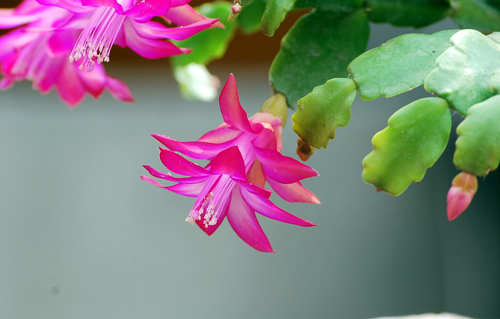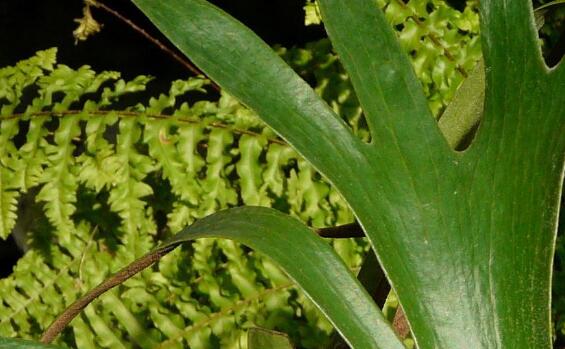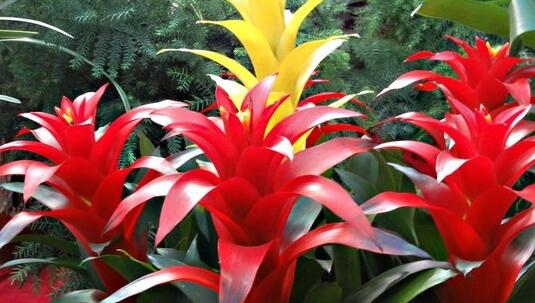The cultivation method of crab foot lotus flowers are delicate and graceful
Crab foot lotus is crab claw orchid is evergreen perennial flowers. Generally flowering during the winter festival, the flowers are delicate and graceful, beautiful and beautiful, especially loved and sought after by the Chinese people. Here is a look at the breeding methods of crab foot lotus.

The cultivation method of crab foot lotus:
1. soil
The soil should be a mixture of fertile moldy soil, peat and coarse sand, and the pH should be maintained between 5.5 and 6.5.
2. watering
Crabapple orchid watering can not be too much. Otherwise, it may cause root rot. Water every 3 to 4 days in cooler seasons, but reduce watering after September, and water every 1 to 2 days in high temperature periods. It is also better to spray water to humidify leaves when it is high temperature and dry; it is OK to irrigate water once a week during the winter, and it is necessary to flexibly master it according to the weather. Usually, when the potted topsoil is dry, it is necessary to irrigate it.
3. fertilization
Fertilization can promote the rapid growth of crab claw orchid. Fertilization is generally carried out in spring, with compound fertilizer 800~1000 times solution with N: P: K ratio of 2:1:2, once a week. Fertilization should be stopped at high temperature and resumed in autumn, but it is best to increase the proportion of P and K fertilizer and reduce the proportion of N fertilizer at this time, which can promote bud development. Fertilization must be stopped during flowering and dormancy.
4. illumination
The cultivation environment of crab claw orchid requires semi-shade and moisture. Avoid sun exposure and rain in summer, and warm and sunny in winter. Summer high temperature should pay attention to humidification, ventilation, cooling, if necessary, the use of shading nets. Shading nets are gradually retracted at the end of autumn. Winter to strengthen heat preservation, cold, if the temperature is low to use heating.
5 shaping
Shaping is generally carried out in spring and autumn. After flowering, 3~4 stem nodes under residual flowers should be cut short in time, and diseased, old, dense and introverted stem nodes should be removed, which is conducive to ventilation and maintenance; if 4~5 new branches grow from the top of a node, 2~3 new branches should be removed and 2 can be left. Autumn shaping is generally to remove immature stem nodes that cannot bud to ensure a concentrated supply of nutrients to buds.
6. pest
The disease of crab claw orchid is generally caused by improper management of water and fertilizer. Strengthening tax management, controlling light temperature and timely prevention are the main methods. Insect pests are mainly caused by over-density, poor growth and poor ventilation. The main method is to shape and prune branches and remove insect branches and diseased branches in time. Pay attention to timely observation, mainly to prevention.
Water lily-cultivation method of water lily| Water lily pictures| Water lily (Latin scientific name: Nymphaea alba), also known as meridian lily, cress flower, lotus flower, small lotus flower, etc., is a perennial aquatic plant belonging to the genus Nymphaea of the water lily family. Water lily is a precious flower among aquatic flowers. It is similar in appearance to lotus, except that lotus leaves and flowers stand out of the water, while water lily leaves and flowers float on the water. Water lilies are known as "sleeping beauty in flowers" because they are comfortable during the day and rolled at night. Water lily is widely used for food, tea, cut flowers, medicinal purposes. Water lily pictures
Water lily,(Latin scientific name: Nymphaea tetragona Georgi), also known as meridian lily, cress flower, is a Ranunculus water lily family plants. Perennial aquatic herbs; rhizomes plump. Leaves dimorphic: floating leaves round or ovate, base with curved, cordate or arrow-shaped, often without leaves; submerged leaves membranous, fragile. Flowers large, beautiful, floating or above water; sepals nearly free;
How to raise water lily
1. The main propagation method of water lily is plant division propagation. In March to April every year, when the bud has just sprouted, the rhizome will be dug up and divided into several pieces with a sharp knife. Make sure there are more than two full bud eyes on the rhizome and plant it into the river mud in the pond or tank.
2. Sowing and propagation The black oval plump seeds are stored in clean water until they are removed before sowing in the following spring. 5℃ to 30℃ water germination, change water every day, two weeks after germination. When the seedlings grow to 3 to 4 cm, they can be planted in the pool to ensure sufficient water depth.
Culture method of water lily
1, soil: water lily on the soil requirements are not strict, pH 6~8, can grow normally, but like rich in organic matter loam is the best, the depth of the pool water in the growing season should not exceed 80 cm.
Water: Water lily planting in summer irrigation depth of about 25 cm, and often maintain this depth. High temperature season should pay attention to keep basin water clean, encounter basin water dirty, should promptly remove dirt for new water.
How to grow mini water lily
1. Rhizome propagation method
Mini water lilies are mainly propagated by rhizomes. At first, the mini water lilies are planted in flower pots and then placed in water. After about a year, the rhizomes of the mini water lilies will grow very dense. This is when the mini water lilies can be planted by stem division. First, the soil on the rhizomes will be removed, the roots will be cut short, and the stems and leaves that grow out will be cut to about 10cm. Then, the basin will be placed in bottom sand fertilizer and the like. The stem sections will be put in. Above with a layer of soil can be solid, timely watering, you can wait for growth.
Water Lily
What is the language of water lilies? In ancient Greece and Rome, water lilies, like Chinese lotus flowers, were regarded as holy and beautiful incarnations and were often sacrificed to goddesses. In the New Testament, there is also a saying that "holy things come out of mud and are not stained." Water lily is a flower born on August 5 every year, flower language: clean, pure, enchanting. The water lily in German mind, flower language is glamorous. Those blessed by this flower are born with an irresistible charm of the opposite sex, but it is difficult to live in peace with same-sex friends.
How to grow water lily seeds
1. Sowing time: Lotus seeds have no dormancy period. As long as the water temperature can be kept above 16℃, they can be sown in all seasons. Lotus seeds need 50-60 days from sowing to flowering in spring and 60-80 days in autumn under suitable conditions of temperature and light.
Prevention and Control of Water Lily Worm Diseases
Water lily insect disease: 1, aphids. Water lily in the growth and development period, if insufficient light, poor ventilation, not only weak growth, and vulnerable to aphid harm. Solution: When pests are found, they can be sprayed with 1200 times of dichlorvos aqueous solution, or killed with tobacco water (50 grams of tobacco leaves and 5 kilograms of water, boiled).
The role of water lily
Water Lily's role: 1, watch
Water lily is perennial water herb, flowers, leaves are beautiful ornamental plants, rich in color, long flowering period, deeply loved by people, planted in the lake, pond shore, or dotted in the garden waterscape and a corner of the rockery, has good ornamental value.
Difference between water lily and lotus
Both belong to the Nymphaeaceae family, and differ in the following ways:
Water lily, also known as meridian lily. It belongs to Nymphaeaceae, perennial aquatic flower. Rhizome stout, erect. Leaves floating on water, heart-shaped or broadly elliptic, base deeply curved, bright green above, purple-red below. Flowers single floating water, petals majority, white, pink, red, yellow and other colors, daily morning flowering, afternoon closure, named Meridian, flowering 6 - 9 months. Berry enclosed in persistent sepals. It is native to East Asia and is cultivated throughout China. Born in marshes, likes sunlight and humus-rich clay. Water lily flowers and leaves are beautiful, in addition to ornamental, its rhizomes can be edible or medicinal.
Related encyclopedias
Pocket scale non-woven bag lamp grass bamboo shoots crab feet red rice note3ykk zipper ybs zipper mountain cherry climbing wall plum wild cassia winter plum pine watch Omega Longines famous watch children's building blocks flint azalea orchid roll stick thorn fruit Annona
How to cultivate and manage crab foot orchid
Crab foot orchid leaves evergreen, color has red, white, orange, yellow variety, beautiful shape, especially suitable for family farming. Here's what to watch for in the house.
1. Cultivate soil before planting flowers.
The choice of soil is important for any green plant raised in the family, and crabfoot orchids are no exception. For beginners, cultivating good soil for flowers and plants is half the success. Crab foot orchid likes well drained mixed soil, will decay leaf soil, peat and coarse sand mixed together, maintain soil pH in acidic conditions, pH value around 6 can be.
Second, temperature and sun requirements.
Crab orchids prefer a semi-shady, humid environment. The growth temperature is between 18 and 23 degrees Celsius, while the flowering temperature is between 10 and 15 degrees Celsius. Above 25 degrees Celsius, they do not bloom or bloom less. Crab claw orchid indoor light culture can, summer can not be exposed to the sun, to avoid rain, winter indoor culture, temperature should not be lower than ten degrees. The flowering period of crab foot orchid is about October every year. About two months before flowering, the daily sunshine shall not be less than eight hours, and the buds can bloom at the end of September and early October.
Third, water.
How to water green plants is a cliché problem, plants or wet, or dry temperament different, according to their characteristics to give water. Crab foot orchid can grow in dry environment, too much water in the basin is easy to rot root death. So to crab foot orchid watering to a full watering, but to avoid water accumulation silt, can wait until the soil in the basin dry and then watering, can not be too diligent oh.
Under normal circumstances, four or five days in winter about irrigation water, summer water evaporation faster, two days irrigation water can be. If the weather is hot, you can spray mist water on the leaves, moisturizing also has a cooling effect.
Need to remind you that when the crab foot orchid into flowering, you can not let the soil too dry, otherwise the buds will fall off, but too much watering will also fall buds. After flowering, the plant temporarily dormancy, at this time can let the pot soil dry some.
IV. Reproduction
The propagation method of crab claw orchid is very simple. Cut off strong stem nodes, place them in shade for two days, insert sand and survive. Is it very simple?
5. Flowering management.
It has been mentioned above that too little or too much watering at flowering time of crab claw orchid is easy to cause bud drop, so how much water is appropriate? You observe the pot soil in the wet state, with the hands of the soil can not be scattered, can be sprayed with room temperature mist water at noon every day. In addition, attention should be paid to stopping fertilization during flowering to prevent flower fertilizer from burning flowers.
6. Fertilization.
Fertilization time is generally carried out in September before flowering and April after flowering. Nitrogen fertilizer is applied in spring, mainly nutrient branches and leaves. Fertilization is stopped in summer to avoid decay. Phosphorus fertilizer is mainly used in autumn. Attention should be paid not to use strong chemical fertilizer.
VII. Other matters needing attention.
1, to find a suitable position for crab foot orchid at home, both to ensure adequate sun exposure, but also to the appropriate temperature. Once the position is determined, don't move it often, especially during flowering. It is easy to drop buds by moving the position at will.
2, crab claw orchid can not live in strong sunlight, summer to moderate shade, otherwise it will hurt the plant.
The above is the precautions for breeding crab claw orchid. Generally speaking, it is a relatively easy to survive domestic green plant. After careful care, it can generally bloom. Have you learned it?
- Prev

What are the breeding methods of antler fern?
Antler fern, also known as Dryopteris, bat fern, antler fern and so on, is a plant of the genus Dryopteris of Polypodiaceae. How to raise antler fern? Let's take a look at the breeding method of antler fern with the editor. How to raise the antler fern: the choice of soil for the cultivation method of the antler fern, which is an epiphyte
- Next

Is the pineapple poisonous? what are the breeding methods?
Is the pineapple poisonous? Pineapple also has a name, called the head of good luck. After many people buy pineapple flowers home, they don't know how to raise them, so let's take a look at the culture methods of pineapple flowers. Pineapple culture methods: (1) Water is the source of life and the key to development.
Related
- Fuxing push coffee new agricultural production and marketing class: lack of small-scale processing plants
- Jujube rice field leisure farm deep ploughing Yilan for five years to create a space for organic food and play
- Nongyu Farm-A trial of organic papaya for brave women with advanced technology
- Four points for attention in the prevention and control of diseases and insect pests of edible fungi
- How to add nutrient solution to Edible Fungi
- Is there any good way to control edible fungus mites?
- Open Inoculation Technology of Edible Fungi
- Is there any clever way to use fertilizer for edible fungus in winter?
- What agents are used to kill the pathogens of edible fungi in the mushroom shed?
- Rapid drying of Edible Fungi

